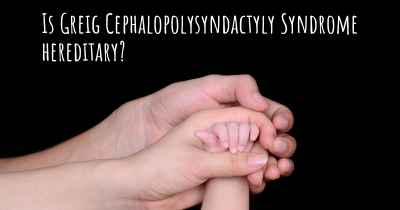Can people with Greig Cephalopolysyndactyly Syndrome work? What kind of work can they perform?
See how people with experience in Greig Cephalopolysyndactyly Syndrome give their opinion about whether people with Greig Cephalopolysyndactyly Syndrome can work and what kind of jobs are more appropriated for people with Greig Cephalopolysyndactyly Syndrome

Can people with Greig Cephalopolysyndactyly Syndrome work?
Greig Cephalopolysyndactyly Syndrome (GCPS) is a rare genetic disorder that affects the development of the limbs, head, and face. It is characterized by various physical abnormalities, including extra fingers or toes, fused or webbed digits, and craniofacial anomalies. While GCPS can present challenges in certain areas, it does not necessarily prevent individuals from pursuing employment and leading fulfilling professional lives.
It is important to note that the impact of GCPS can vary significantly from person to person. Some individuals may have mild manifestations of the syndrome, while others may experience more severe physical limitations. The ability to work will depend on the specific symptoms and functional abilities of each individual.
Work Opportunities for Individuals with GCPS
Despite the physical challenges associated with GCPS, there are various work opportunities available for individuals with the syndrome. The key is to find a job that aligns with their abilities, interests, and strengths. Here are some potential work options:
- Office-based jobs: Many office-based jobs do not require extensive physical labor and can be suitable for individuals with GCPS. These may include administrative roles, customer service positions, data entry, bookkeeping, or office management.
- Technology-related jobs: The field of technology offers numerous opportunities for individuals with GCPS. Jobs such as computer programming, software development, graphic design, or IT support can be well-suited for individuals with GCPS, as they primarily involve cognitive skills rather than physical dexterity.
- Creative professions: Individuals with GCPS often possess unique perspectives and creative talents. They may excel in artistic fields such as painting, sculpting, photography, or writing. Pursuing a career in the arts allows individuals to express themselves and showcase their creativity.
- Entrepreneurship: Some individuals with GCPS may choose to start their own businesses or work as freelancers. This allows them to have more control over their work environment and tailor their job responsibilities to their abilities and preferences.
- Advocacy and support roles: Individuals with GCPS can also consider careers in advocacy and support for individuals with disabilities. They can work for non-profit organizations, government agencies, or educational institutions to raise awareness, provide support services, and advocate for the rights of individuals with disabilities.
Conclusion
While Greig Cephalopolysyndactyly Syndrome may present physical challenges, it does not necessarily prevent individuals from pursuing meaningful employment. The key is to identify work opportunities that align with their abilities, interests, and strengths. With the right support, accommodations, and a positive work environment, individuals with GCPS can lead fulfilling professional lives and contribute to society in various fields.
Posted Oct 18, 2018 by Alexzander 3000








